Shading-Dependent Greening Process of the Leaves in the Light-Sensitive Albino Tea Plant ‘Huangjinya’: Possible Involvement of the Light-Harvesting Complex II Subunit of Photosystem II in the Phenotypic Characteristic
Abstract
:1. Introduction
2. Results
2.1. Changes in Phenotype Characteristics during Shading Treatment
2.2. Changes in Chloroplast Ultrastructure during Shading Treatment
2.3. Changes in the PPCs during Shading Treatment
2.4. Variations of the PSII and LHCII Subunits during Shading Treatment
2.5. Variation of the Gene Expression after Shading Treatment
3. Discussion
3.1. Normalization of Leaf Color and Function Needed Thylakoid Structure Recovery
3.2. Proper Assembly of PPCs Needed for the LHCII Subunits
3.3. Low-Level Expression of the Lhcbs Was Modulated by GUN1-PTM-ABI4
4. Materials and Methods
4.1. Plant Materials and Chemicals
4.2. Shading Treatment
4.3. Measurement of Chlorophyll a Fluorescence Transient
4.4. Analysis of Photosynthetic Pigments
4.5. Transmission Electron Microscopy (TEM) Observation
4.6. Analysis of the PSII and LHCII Subunits
4.7. Analysis of the Pigment-Protein Complexes (PPCs)
4.8. Transcriptomic Analysis and qPCR Confirmation
4.9. Statistical Analysis
5. Conclusions
Supplementary Materials
Author Contributions
Funding
Institutional Review Board Statement
Informed Consent Statement
Data Availability Statement
Acknowledgments
Conflicts of Interest
References
- Oba, S.; Nagata, C.; Nakamura, K.; Fujii, K.; Kawachi, T.; Takatsuka, N.; Shimizu, H. Consumption of Coffee, Green Tea, Oolong Tea, Black Tea, Chocolate Snacks and the Caffeine Content in Relation to Risk of Diabetes in Japanese Men and Women. Br. J. Nutr. 2010, 103, 453–459. [Google Scholar] [CrossRef] [PubMed] [Green Version]
- Shin, Y.H.; Yang, R.; Shi, Y.L.; Li, X.M.; Fu, Q.Y.; Lu, J.L.; Ye, J.H.; Wang, K.R.; Ma, S.C.; Zheng, X.Q. Light-Sensitive Albino Tea Plants and Their Characterization. Hortscience 2018, 53, 144–147. [Google Scholar] [CrossRef]
- Yamashita, H.; Kambe, Y.; Ohshio, M.; Kunihiro, A.; Tanaka, Y.; Suzuki, T.; Nakamura, Y.; Morita, A.; Ikka, T. Integrated Metabolome and Transcriptome Analyses Reveal Etiolation-Induced Metabolic Changes Leading to High Amino Acid Contents in a Light-Sensitive Japanese Albino Tea Cultivar. Front. Plant Sci. 2021, 11, 611140. [Google Scholar] [CrossRef] [PubMed]
- Zhang, C.Y.; Wang, M.H.; Gao, X.Z.; Zhou, F.; Shen, C.W.; Liu, Z.H. Multi-Omics Research in Albino Tea Plants: Past, Present, and Future. Sci. Hortic. 2020, 261, 108943. [Google Scholar] [CrossRef]
- Li, N.N.; Yang, Y.P.; Ye, J.H.; Lu, J.L.; Zheng, X.Q.; Liang, Y.R. Effects of Sunlight on Gene Expression and Chemical Composition of Light-Sensitive Albino Tea Plant. Plant Growth Regul. 2016, 78, 253–262. [Google Scholar] [CrossRef]
- Silva, L.A.S.; Sampaio, V.F.; Barbosa, L.C.S.; Machado, M.; Flores-Borges, D.N.A.; Sales, J.F.; de Oliveira, D.C.; Mayer, J.L.S.; Kuster, V.C.; Rocha, D.I. Albinism in Plants–Far Beyond the Loss of Chlorophyll: Structural and Physiological Aspects of Wild-Type and Albino Royal Poinciana (Delonix regia) Seedlings. Plant Biol. 2020, 22, 761–768. [Google Scholar] [CrossRef]
- Fan, Y.G.; Zhao, X.X.; Wang, H.Y.; Tian, Y.Y.; Xiang, Q.Z.; Zhang, L.X. Effects of Light Intensity on Metabolism of Light-Harvesting Pigment and Photosynthetic System in Camellia sinensis L. Cultivar ‘Huangjinya’. Environ. Exp. Bot. 2019, 166, 103796. [Google Scholar] [CrossRef]
- Li, C.F.; Ma, J.Q.; Huang, D.J.; Ma, C.L.; Jin, J.Q.; Yao, M.Z.; Chen, L. Comprehensive Dissection of Metabolic Changes in Albino and Green Tea Cultivars. J. Agric. Food Chem. 2018, 66, 2040–2048. [Google Scholar] [CrossRef]
- Wu, Q.J.; Chen, Z.D.; Sun, W.J.; Deng, T.T.; Chen, M.J. De Novo Sequencing of the Leaf Transcriptome Reveals Complex Light-Responsive Regulatory Networks in Camellia sinensis Cv. Baijiguan. Front. Plant Sci. 2016, 7, 332. [Google Scholar] [CrossRef] [Green Version]
- Li, C.F.; Xu, Y.X.; Ma, J.Q.; Jin, J.Q.; Huang, D.J.; Yao, M.Z.; Ma, C.L.; Chen, L. Biochemical and Transcriptomic Analyses Reveal Different Metabolite Biosynthesis Profiles among Three Color and Developmental Stages in ‘Anji Baicha’ (Camellia sinensis). BMC Plant Biol. 2016, 16, 195. [Google Scholar] [CrossRef] [Green Version]
- Wang, L.; Yue, C.; Cao, H.L.; Zhou, Y.H.; Zeng, J.M.; Yang, Y.J.; Wang, X.C. Biochemical and Transcriptome Analyses of a Novel Chlorophyll-Deficient Chlorina Tea Plant Cultivar. BMC Plant Biol. 2014, 14, 352. [Google Scholar] [CrossRef] [Green Version]
- Dong, F.; Shi, Y.Z.; Liu, M.Y.; Fan, K.; Zhang, Q.F.; Ruan, J.Y. ITRAQ-Based Quantitative Proteomics Analysis Reveals the Mechanism Underlying the Weakening of Carbon Metabolism in Chlorotic Tea Leaves. Int. J. Mol. Sci. 2018, 19, 3943. [Google Scholar] [CrossRef] [Green Version]
- Cai, W.H.; Zheng, X.Q.; Liang, Y.R. High Light Induced Degradation of Photosystem II Subunits’ Involvement in the Albino Phenotype in Tea Plants. Int. J. Mol. Sci. 2022, 23, 8522. [Google Scholar] [CrossRef]
- Wang, J.Y.; Chen, J.D.; Wang, S.L.; Chen, L.; Ma, C.L.; Yao, M.Z. Repressed Gene Expression of Photosynthetic Antenna Proteins Associated with Yellow Leaf Variation as Revealed by Bulked Segregant RNA-Seq in Tea Plant Camellia sinensis. J. Agric. Food Chem. 2020, 68, 8068–8079. [Google Scholar] [CrossRef] [PubMed]
- Papageorgiou, G.C.; Tsimilli-Michael, M.; Stamatakis, K. The Fast and Slow Kinetics of Chlorophyll a Fluorescence Induction in Plants, Algae and Cyanobacteria: A Viewpoint. Photosynth. Res. 2007, 94, 275–290. [Google Scholar] [CrossRef]
- Wang, P.; Grimm, B. Connecting Chlorophyll Metabolism with Accumulation of the Photosynthetic Apparatus. Trends Plant Sci. 2021, 26, 484–495. [Google Scholar] [CrossRef]
- Jahns, P.; Holzwarth, A.R. The Role of the Xanthophyll Cycle and of Lutein in Photoprotection of Photosystem II. Biochim. Biophys. Acta (BBA) Bioenerg. 2012, 1817, 182–193. [Google Scholar] [CrossRef] [PubMed] [Green Version]
- Bartley, G.E.; Scolnik, P.A. Plant Carotenoids: Pigments for Photoprotection, Visual Attraction, and Human Health. Plant Cell 1995, 7, 1027. [Google Scholar] [CrossRef] [PubMed] [Green Version]
- Melis, A. Dynamics of Photosynthetic Membrane Composition and Function. Biochim. Biophys. Acta (BBA) Bioenerg. 1991, 1058, 87–106. [Google Scholar] [CrossRef]
- Rantala, M.; Rantala, S.; Aro, E.M. Composition, Phosphorylation and Dynamic Organization of Photosynthetic Protein Complexes in Plant Thylakoid Membrane. Photochem. Photobiol. Sci. 2020, 19, 604–619. [Google Scholar] [CrossRef] [Green Version]
- Nelson, N.; Yocum, C.F. Structure and Function of Photosystems I and II. Annu. Rev. Plant Biol. 2006, 57, 521–565. [Google Scholar] [CrossRef] [PubMed] [Green Version]
- Stirbet, A.; Govindjee. On the Relation between the Kautsky Effect (Chlorophyll a Fluorescence Induction) and Photosystem II: Basics and Applications of the OJIP Fluorescence Transient. J. Photochem. Photobiol. B Biol. 2011, 104, 236–257. [Google Scholar] [CrossRef]
- Chen, X.F.; Li, J.J.; Yu, Y.; Kou, X.B.; Periakaruppan, R.; Chen, X.; Li, X.H. Stay-Green and Light-Harvesting Complex II Chlorophyll a/b Binding Protein are Involved in Albinism of a Novel Albino Tea Germplasm ‘Huabai 1’. Sci. Hortic. 2022, 293, 110653. [Google Scholar] [CrossRef]
- Ruban, A.V.; Wentworth, M.; Yakushevska, A.E.; Andersson, J.; Lee, P.J.; Keegstra, W.; Dekker, J.P.; Boekema, E.J.; Jansson, S.; Horton, P. Plants Lacking the Main Light-Harvesting Complex Retain Photosystem II Macro-Organization. Nature 2003, 421, 648–652. [Google Scholar] [CrossRef] [Green Version]
- Pietrzykowska, M.; Suorsa, M.; Semchonok, D.A.; Tikkanen, M.; Boekema, E.J.; Aro, E.M.; Jansson, S. The Light-Harvesting Chlorophyll a/b Binding Proteins Lhcb1 and Lhcb2 Play Complementary Roles during State Transitions in Arabidopsis. Plant Cell 2014, 26, 3646–3660. [Google Scholar] [CrossRef] [PubMed] [Green Version]
- Grieco, M.; Suora, M.; Jajoo, A.; Tikkanen, M.; Aro, E.M. Light-harvesting II antenna trimers connect energetically the entire photosynthetic machinery—Including both photosystems II and I. Biochim. Biophys. Acta (BBA) Bioenerg. 2015, 1847, 607–619. [Google Scholar] [CrossRef] [Green Version]
- Ballottari, M.; Girardon, J.; Betterle, N.; Morosinotto, T.; Bassi, R. Identification of the Chromophores Involved in Aggregation-Dependent Energy Quenching of the Monomeric Photosystem II Antenna Protein Lhcb5. J. Biol. Chem. 2010, 285, 28309–28321. [Google Scholar] [CrossRef] [Green Version]
- Kirst, H.; Melis, A. The Chloroplast Signal Recognition Particle (CpSRP) Pathway as a Tool to Minimize Chlorophyll Antenna Size and Maximize Photosynthetic Productivity. Biotechnol. Adv. 2014, 32, 66–72. [Google Scholar] [CrossRef]
- Ziehe, D.; Dünschede, B.; Schünemann, D. Molecular Mechanism of SRP-Dependent Light-Harvesting Protein Transport to the Thylakoid Membrane in Plants. Photosynth. Res. 2018, 138, 303–313. [Google Scholar] [CrossRef] [Green Version]
- Henry, R.L. SRP: Adapting to Life in the Chloroplast. Nat. Struct. Mol. Biol. 2010, 17, 676–677. [Google Scholar] [CrossRef]
- Wang, P.; Grimm, B. Comparative Analysis of Light-Harvesting Antennae and State Transition in Chlorina and CpSRP Mutants. Plant Physiol. 2016, 172, 1519–1531. [Google Scholar] [CrossRef] [PubMed] [Green Version]
- Butow, R.A.; Avadhani, N.G. Mitochondrial Signaling: The Retrograde Response. Mol. Cell 2004, 14, 1–15. [Google Scholar] [CrossRef]
- Nott, A.; Jung, H.S.; Koussevitzky, S.; Chory, J. Plastid-to-Nucleus Retrograde Signaling. Annu. Rev. Plant Biol. 2006, 57, 739–759. [Google Scholar] [CrossRef]
- Chan, K.X.; Phua, S.Y.; Crisp, P.; McQuinn, R.; Pogson, B.J. Learning the Languages of the Chloroplast: Retrograde Signaling and Beyond. Annu. Rev. Plant Biol. 2016, 67, 25–53. [Google Scholar] [CrossRef] [PubMed]
- Pesaresi, P.; Kim, C. Current Understanding of GUN1: A Key Mediator Involved in Biogenic Retrograde Signaling. Plant Cell Rep. 2019, 38, 819–823. [Google Scholar] [CrossRef] [PubMed]
- Sun, X.W.; Feng, P.Q.; Xu, X.M.; Guo, H.L.; Ma, J.F.; Chi, W.; Lin, R.C.; Lu, C.M.; Zhang, L.X. A Chloroplast Envelope-Bound PHD Transcription Factor Mediates Chloroplast Signals to the Nucleus. Nat. Commun. 2011, 2, 477. [Google Scholar] [CrossRef] [Green Version]
- Koussevitzky, S.; Nott, A.; Mockler, T.C.; Hong, F.; Sachetto-Martins, G.; Surpin, M.; Lim, J.; Mittler, R.; Chory, J. Signals from Chloroplasts Converge to Regulate Nuclear Gene Expression. Science 2007, 316, 715–719. [Google Scholar] [CrossRef] [PubMed]
- Shimizu, T.; Kacprzak, S.M.; Mochizuki, N.; Nagatani, A.; Watanabe, S.; Shimada, T.; Tanaka, K.; Hayashi, Y.; Arai, M.; Leister, D. The Retrograde Signaling Protein GUN1 Regulates Tetrapyrrole Biosynthesis. Proc. Natl. Acad. Sci. USA 2019, 116, 24900–24906. [Google Scholar] [CrossRef] [Green Version]
- Richter, A.S.; Nägele, T.; Grimm, B.; Kaufmann, K.; Schroda, M.; Leister, D.; Kleine, T. Retrograde Signaling in Plants: A Critical Review Focusing on the GUN Pathway and Beyond. Plant Commun. 2023, 4, 100511. [Google Scholar] [CrossRef]
- Takahashi, S.; Tamashiro, A.; Sakihama, Y.; Yamamoto, Y.; Kawamitsu, Y.; Yamasaki, H. High-Susceptibility of Photosynthesis to Photoinhibition in the Tropical Plant Ficus microcarpa L. f. cv. Golden Leaves. BMC Plant Biol. 2002, 2, 2. [Google Scholar] [CrossRef] [Green Version]
- Aro, E.M.; Suorsa, M.; Rokka, A.; Allahverdiyeva, Y.; Paakkarinen, V.; Saleem, A.; Battchikova, N.; Rintamäki, E. Dynamics of Photosystem II: A Proteomic Approach to Thylakoid Protein Complexes. J. Exp. Bot. 2005, 56, 347–356. [Google Scholar] [CrossRef] [PubMed] [Green Version]
- Nama, S.; Madireddi, S.K.; Yadav, R.M.; Subramanyam, R. Non-Photochemical Quenching-Dependent Acclimation and Thylakoid Organization of Chlamydomonas reinhardtii to High Light Stress. Photosynth. Res. 2019, 139, 387–400. [Google Scholar] [CrossRef] [PubMed]
- Richardson, A.D.; Duigan, S.P.; Berlyn, G.P. An Evaluation of Noninvasive Methods to Estimate Foliar Chlorophyll Content. New Phytol. 2002, 153, 185–194. [Google Scholar] [CrossRef] [Green Version]
- Dhokne, K.; Pandey, J.; Yadav, R.M.; Ramachandran, P.; Rath, J.R.; Subramanyam, R. Change in the Photochemical and Structural Organization of Thylakoids from Pea (Pisum sativum) under Salt Stress. Plant Physiol. Biochem. 2022, 177, 46–60. [Google Scholar] [CrossRef]
- Li, B.; Dewey, C.N. RSEM: Accurate Transcript Quantification from RNA-Seq Data with or without a Reference Genome. BMC Bioinform. 2011, 12, 323. [Google Scholar] [CrossRef] [PubMed] [Green Version]

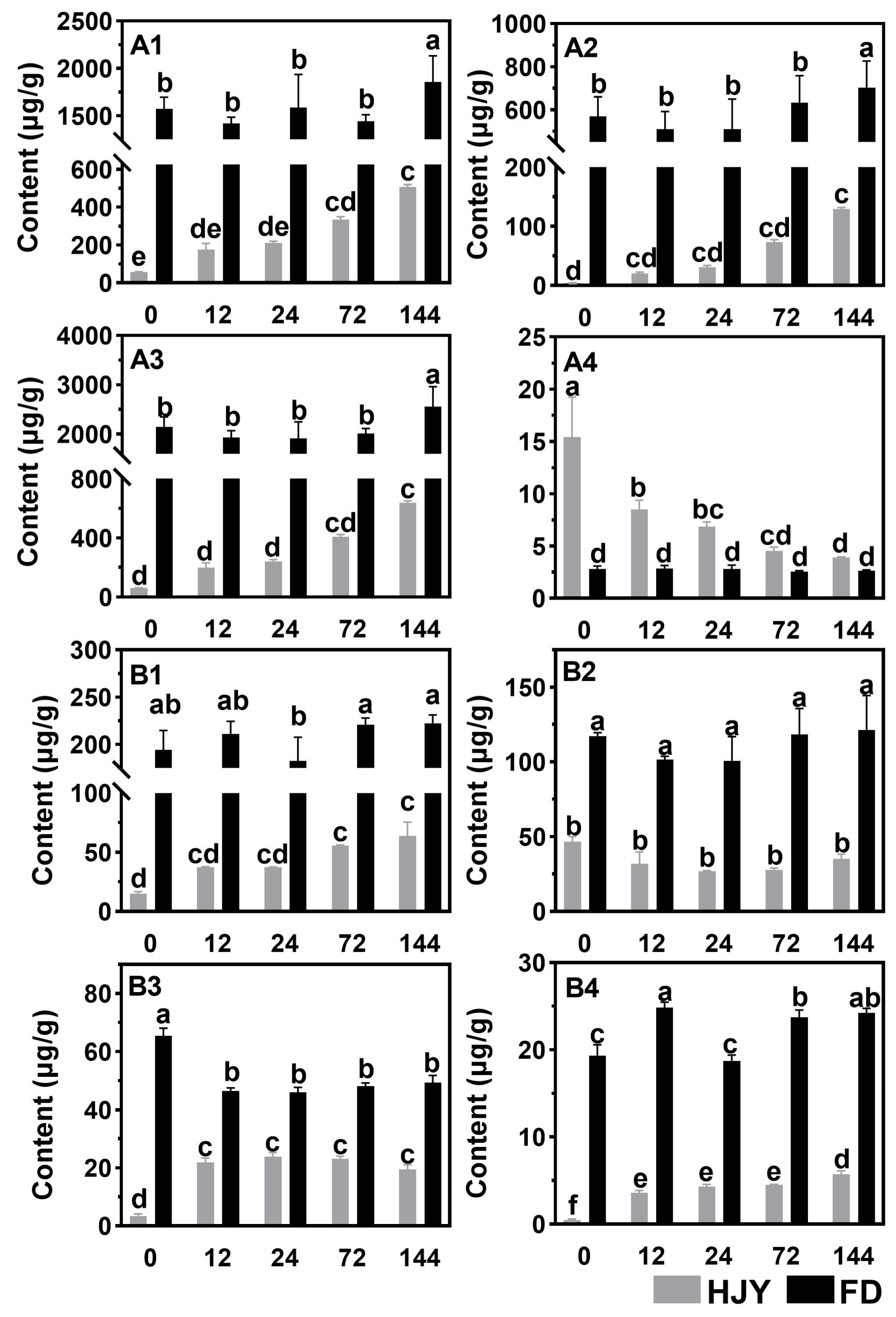
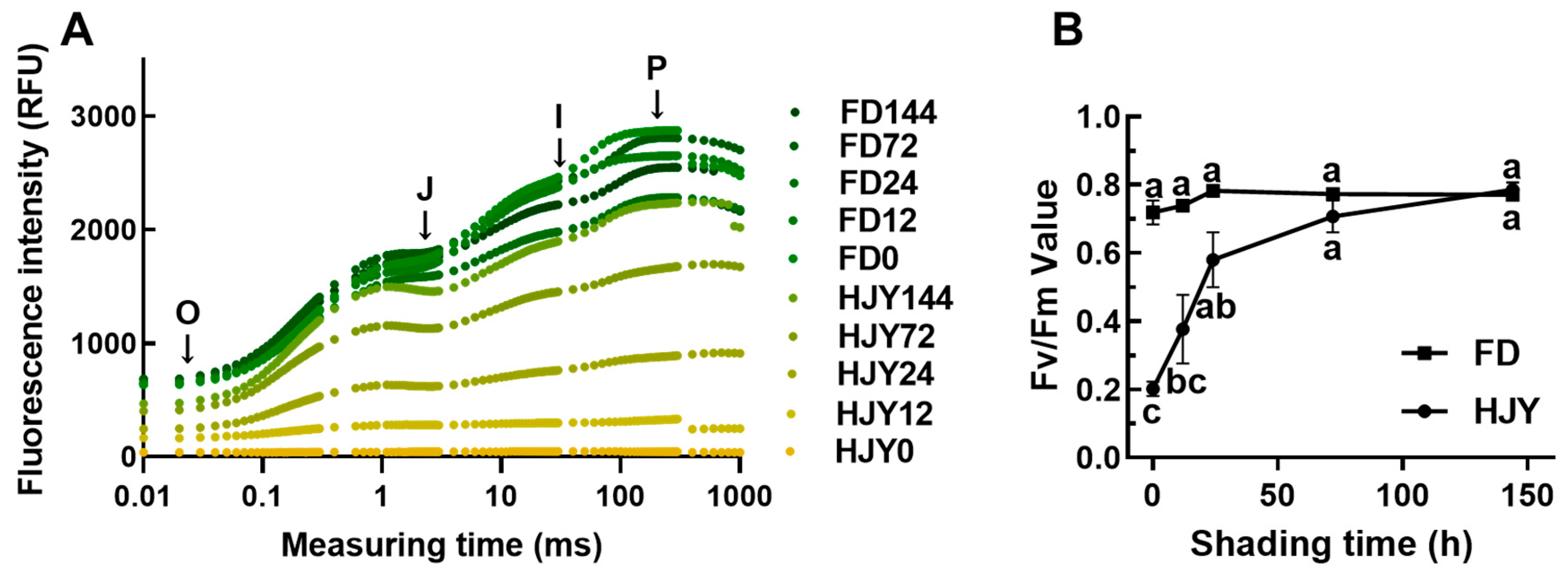
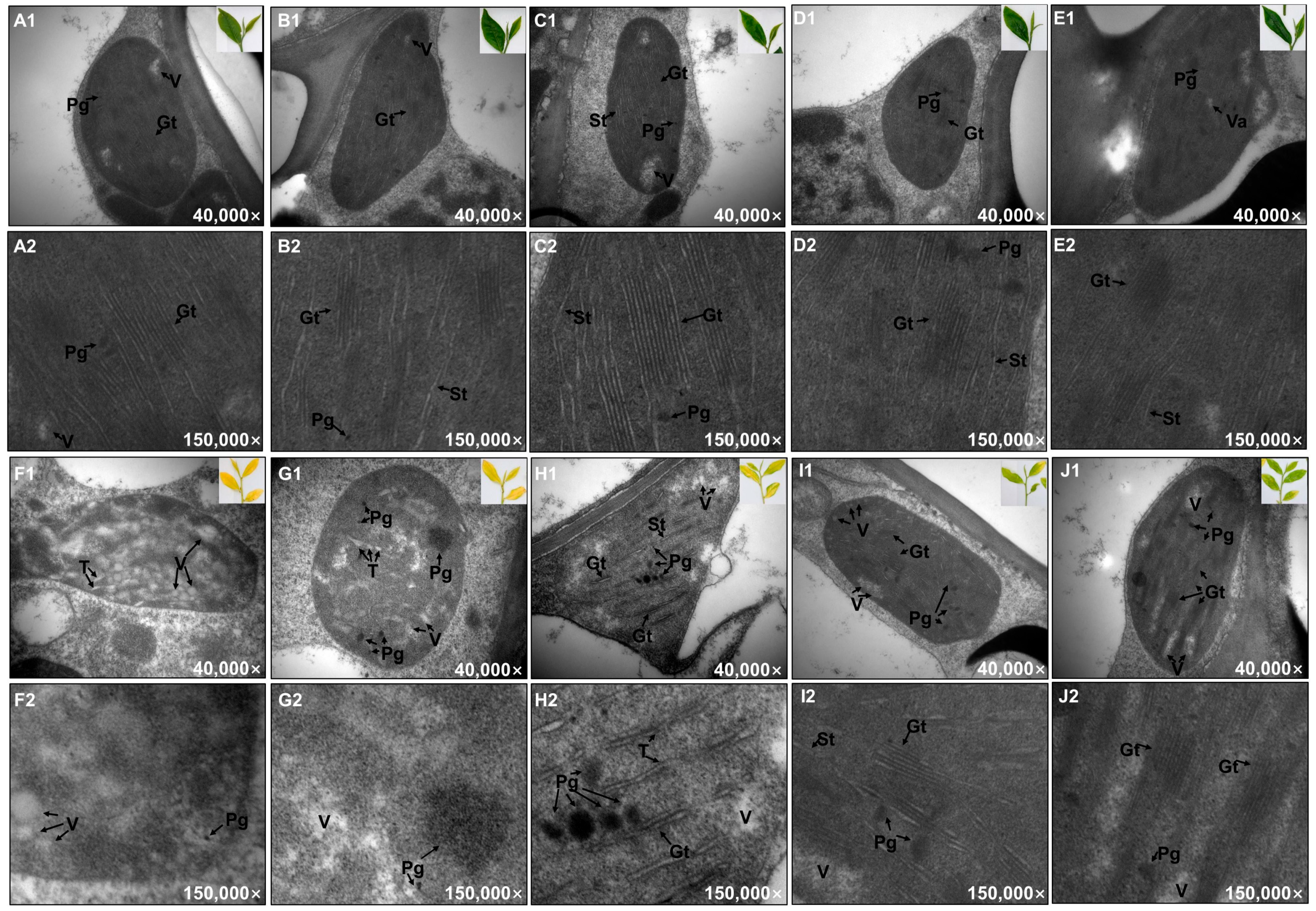
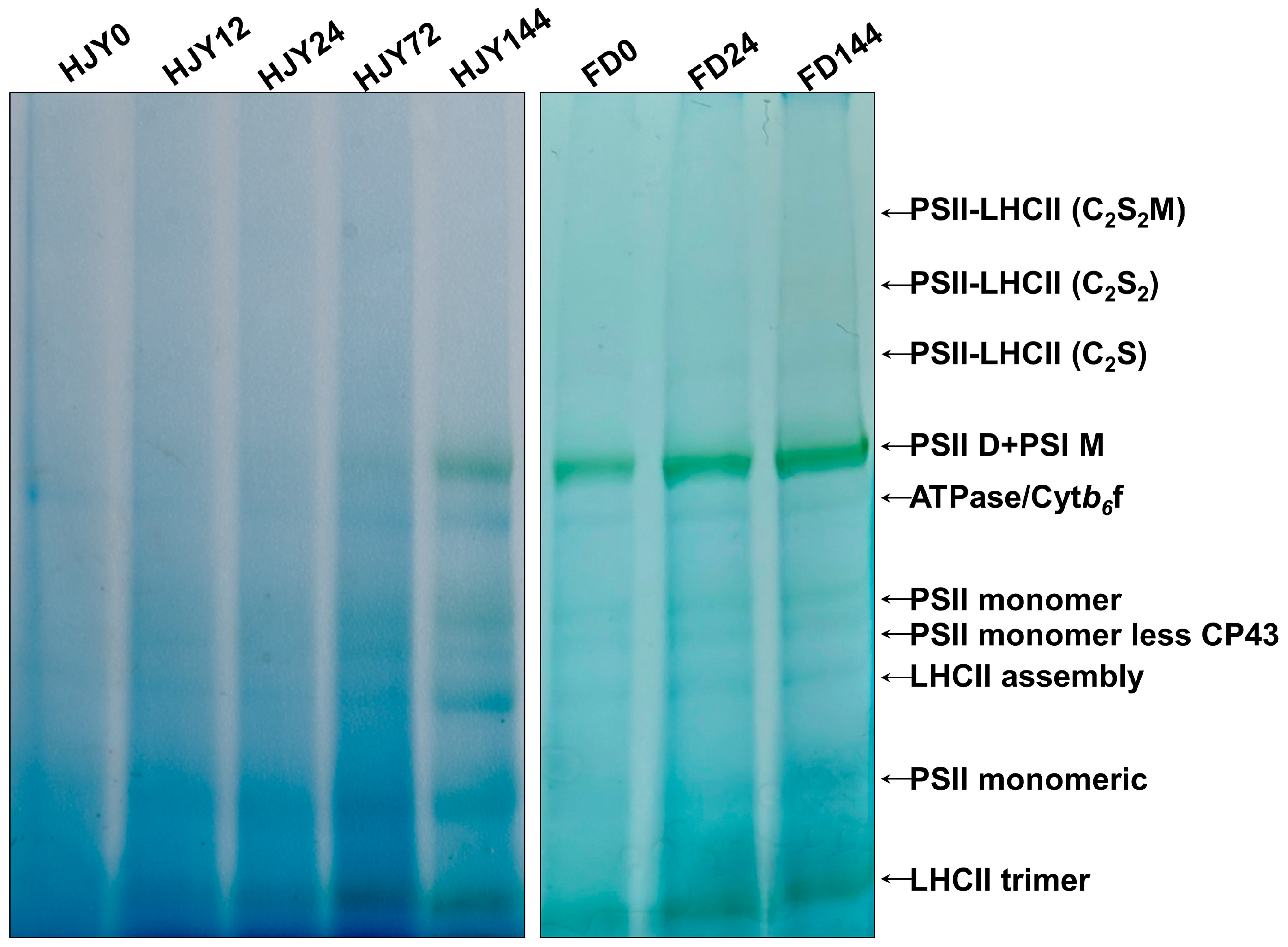
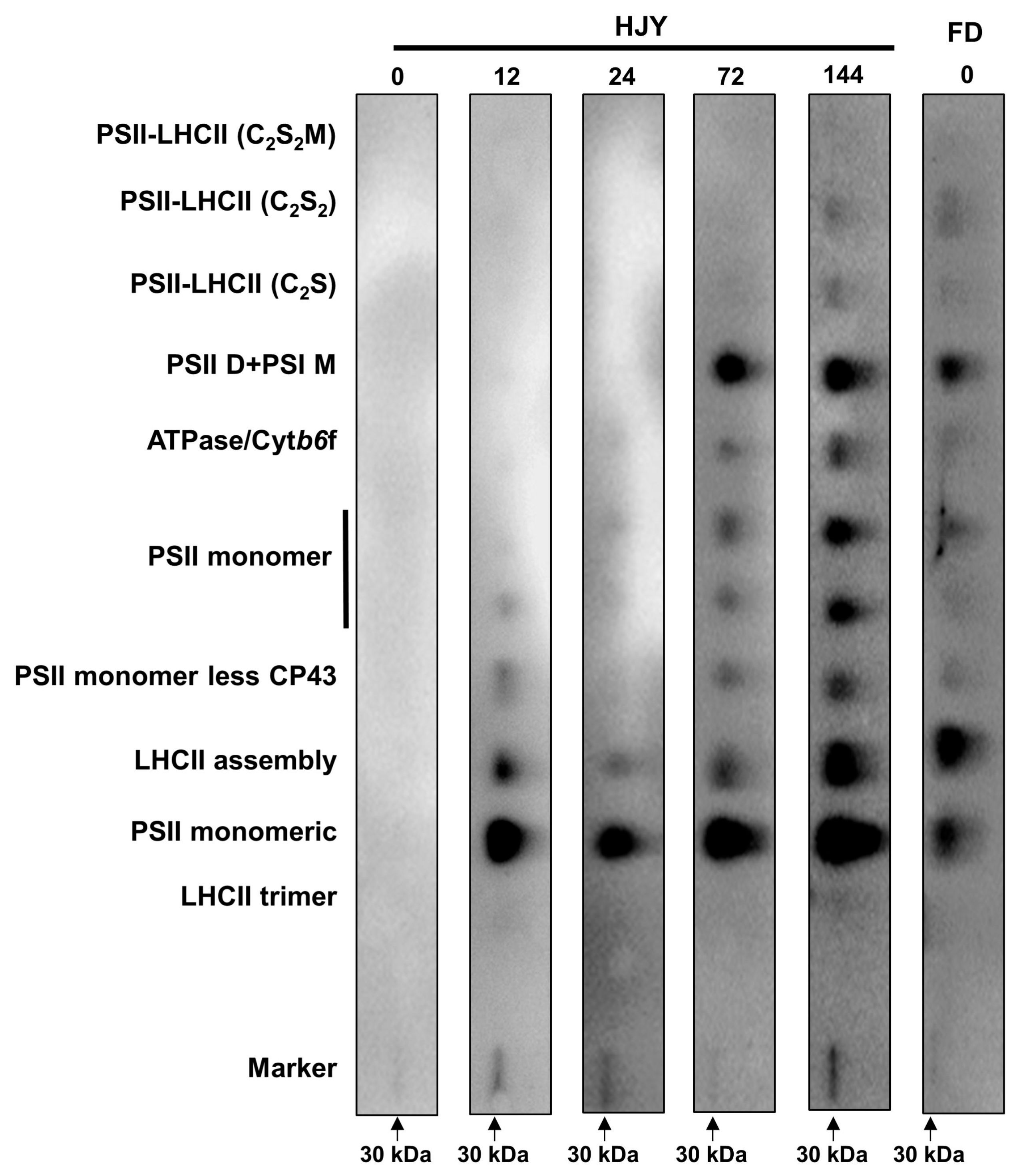
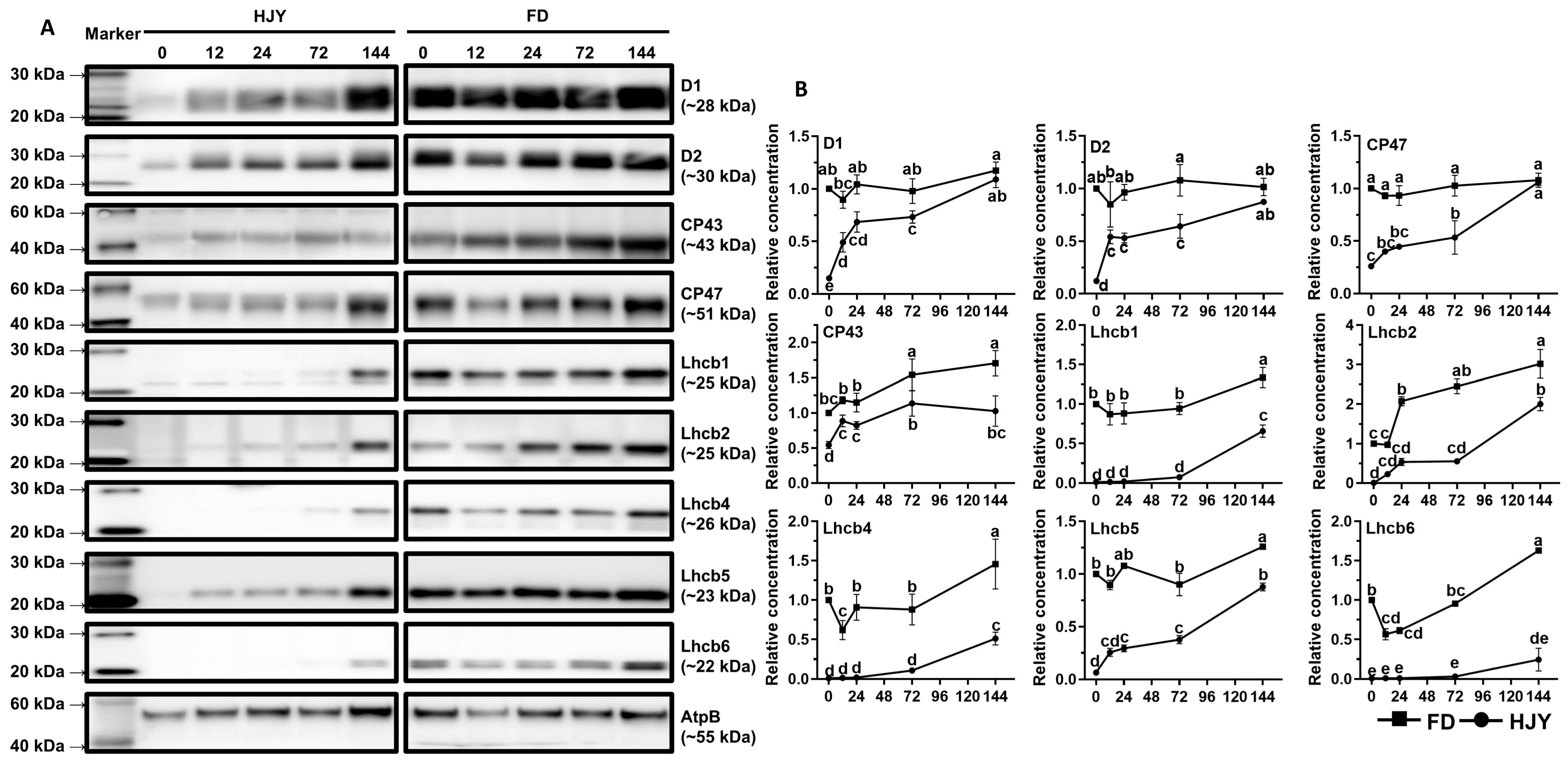

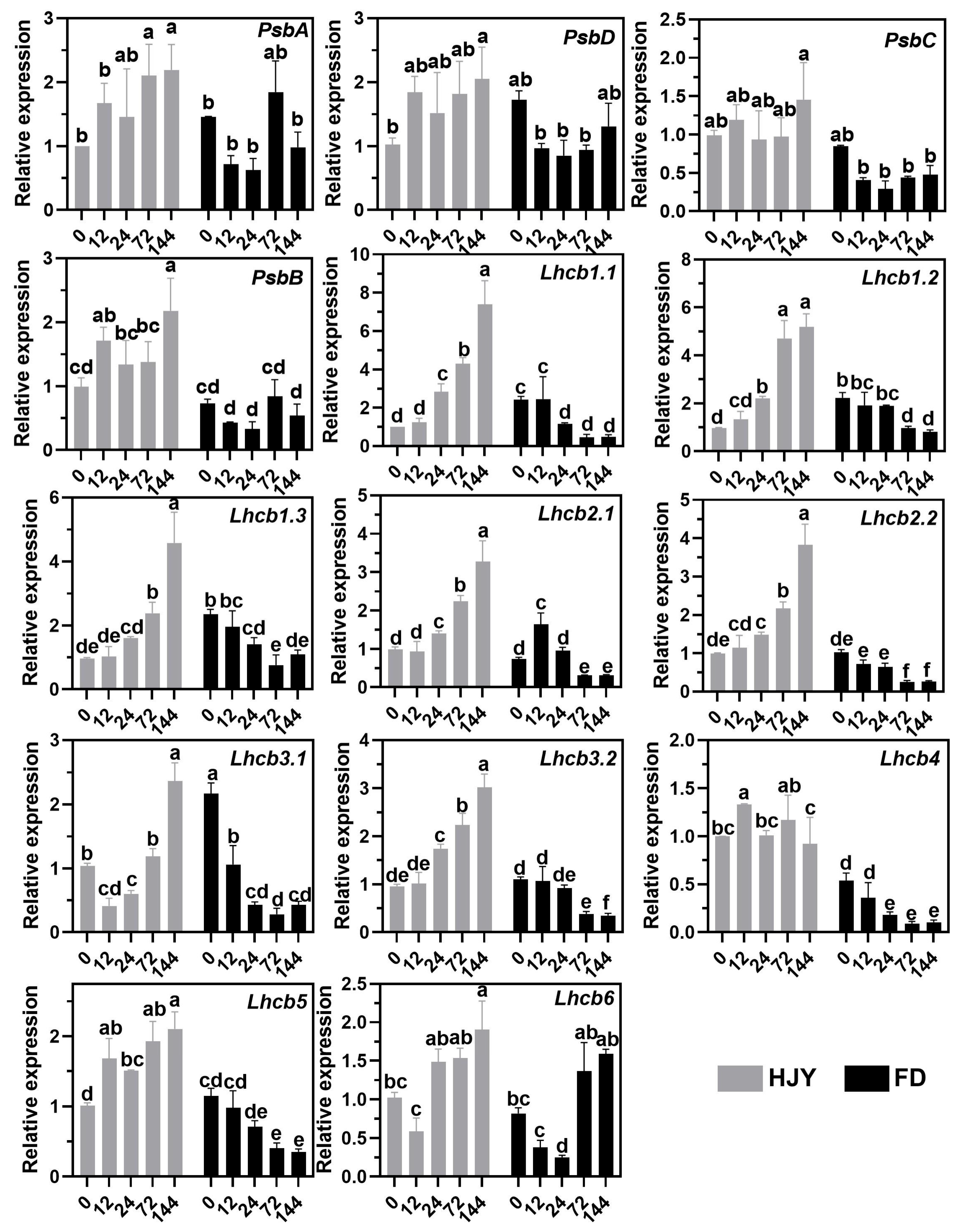
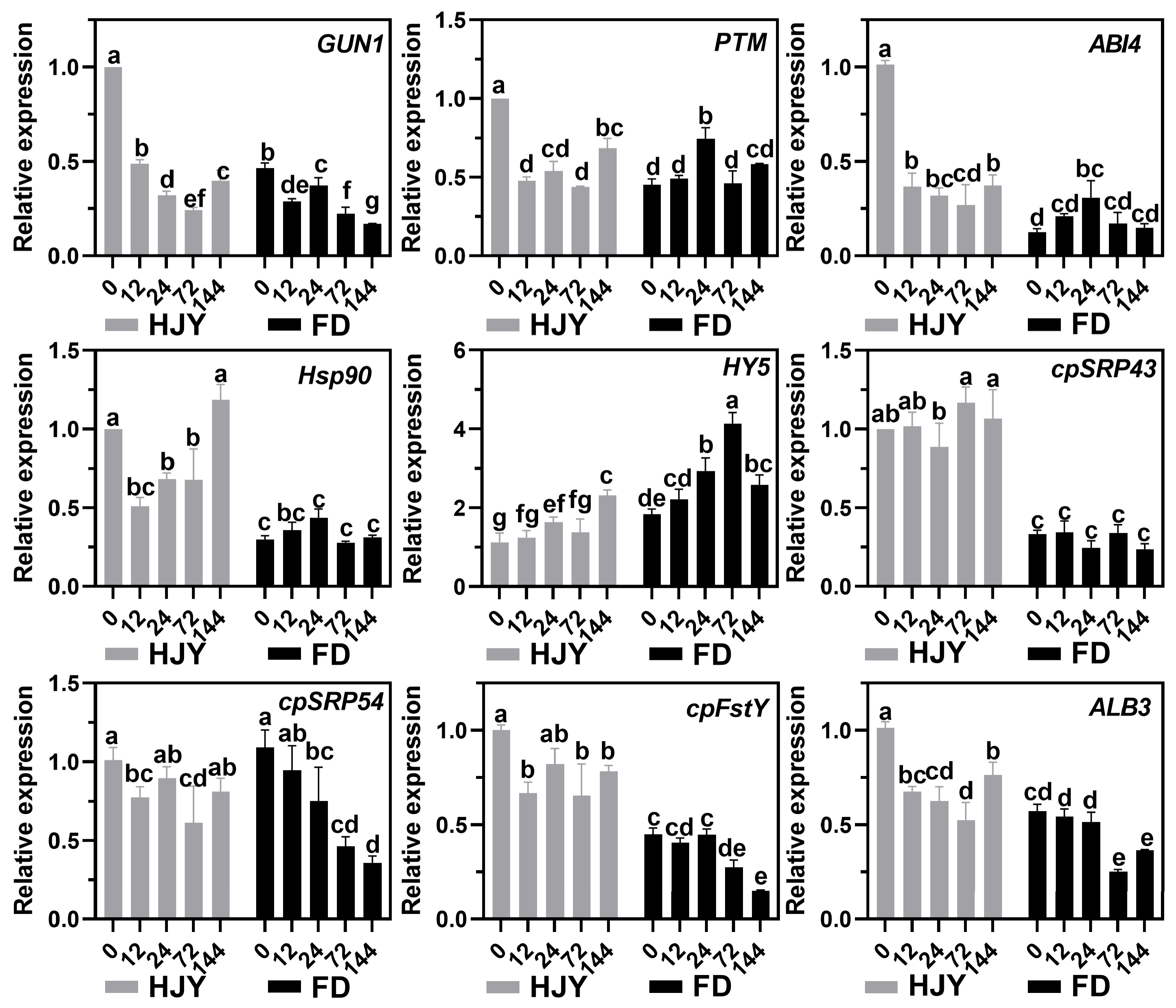

| Item | HJY0 | HJY12 | HJY24 | HJY72 | HJY144 |
|---|---|---|---|---|---|
| Chloroplast area (µm2) | 3.80 ± 1.82 b | 4.52 ± 1.46 ab | 5.44 ± 1.85 a | 4.36 ± 1.61 ab | 4.59 ± 1.81 ab |
| Thylakoid thickness (µm) | 0.000 ± 0.000 c | 0.000 ± 0.000 c | 0.045 ± 0.001 b | 0.112 ± 0.032 ab | 0.197 ± 0.057 a |
| Number of thylakoids in Chloroplast | 2.75 ± 1.71 c | 14.44 ± 7.11 b | 29.70 ± 14.24 a | 30.80 ± 7.28 a | 29.90 ± 7.77 a |
| Thylakoid area (µm2) | 0.030 ± 0.036 ab | 0.014 ± 0.011 b | 0.014 ± 0.005 b | 0.037 ± 0.021 ab | 0.067 ± 0.025 a |
| Thylakoid area density (%) | 0.94 ± 0.63 c | 4.44 ± 2.89 c | 7.64 ± 3.78 c | 25.12 ± 12.15 b | 43.83 ± 9.84 a |
| Number of plastoglobules in chloroplast | 16.00 ± 13.72 ab | 26.60 ± 20.30 a | 10.70 ± 5.62 b | 22.50 ± 10.87 ab | 13.67 ± 8.56 b |
| Plastoglobule area (µm2) | 0.001 ± 0.001 c | 0.005 ± 0.003 ab | 0.007 ± 0.003 a | 0.004 ± 0.002 b | 0.007 ± 0.004 a |
| Plastoglobule area density (%) | 0.25 ± 0.08 b | 2.27 ± 0.92 a | 2.31 ± 1.08 a | 2.24 ± 1.20 a | 1.84 ± 1.06 a |
Disclaimer/Publisher’s Note: The statements, opinions and data contained in all publications are solely those of the individual author(s) and contributor(s) and not of MDPI and/or the editor(s). MDPI and/or the editor(s) disclaim responsibility for any injury to people or property resulting from any ideas, methods, instructions or products referred to in the content. |
© 2023 by the authors. Licensee MDPI, Basel, Switzerland. This article is an open access article distributed under the terms and conditions of the Creative Commons Attribution (CC BY) license (https://creativecommons.org/licenses/by/4.0/).
Share and Cite
Wang, Y.-Q.; Ye, J.-J.; Yang, H.-Z.; Li, D.; Li, X.-X.; Wang, Y.-K.; Zheng, X.-Q.; Ye, J.-H.; Li, Q.-S.; Liang, Y.-R.; et al. Shading-Dependent Greening Process of the Leaves in the Light-Sensitive Albino Tea Plant ‘Huangjinya’: Possible Involvement of the Light-Harvesting Complex II Subunit of Photosystem II in the Phenotypic Characteristic. Int. J. Mol. Sci. 2023, 24, 10314. https://doi.org/10.3390/ijms241210314
Wang Y-Q, Ye J-J, Yang H-Z, Li D, Li X-X, Wang Y-K, Zheng X-Q, Ye J-H, Li Q-S, Liang Y-R, et al. Shading-Dependent Greening Process of the Leaves in the Light-Sensitive Albino Tea Plant ‘Huangjinya’: Possible Involvement of the Light-Harvesting Complex II Subunit of Photosystem II in the Phenotypic Characteristic. International Journal of Molecular Sciences. 2023; 24(12):10314. https://doi.org/10.3390/ijms241210314
Chicago/Turabian StyleWang, Ying-Qi, Jing-Jing Ye, Hong-Zhiyuan Yang, Da Li, Xiao-Xiang Li, Yong-Kang Wang, Xin-Qiang Zheng, Jian-Hui Ye, Qing-Sheng Li, Yue-Rong Liang, and et al. 2023. "Shading-Dependent Greening Process of the Leaves in the Light-Sensitive Albino Tea Plant ‘Huangjinya’: Possible Involvement of the Light-Harvesting Complex II Subunit of Photosystem II in the Phenotypic Characteristic" International Journal of Molecular Sciences 24, no. 12: 10314. https://doi.org/10.3390/ijms241210314






